MGT600 - Strategic People Management: Critical Peer Review Report
VerifiedAdded on 2023/06/08
|8
|1759
|310
Report
AI Summary
This report presents a peer review of a student's analysis of strategic people management principles and theories, as part of the MGT600 Management, People and Teams course. The review assesses the student's understanding of classical management theory versus strategic people management, the importance of team management, ethical considerations in international business, and the role of culture and diversity. It evaluates the effectiveness of different approaches to people management and their impact on organizational and individual performance, highlighting the need for organizations to invest in human resources to gain a competitive advantage. The review also touches upon the importance of continuous improvement of people management skills for overall organizational effectiveness. Desklib offers a wide range of study resources, including solved assignments and past papers, to support students in their academic pursuits.
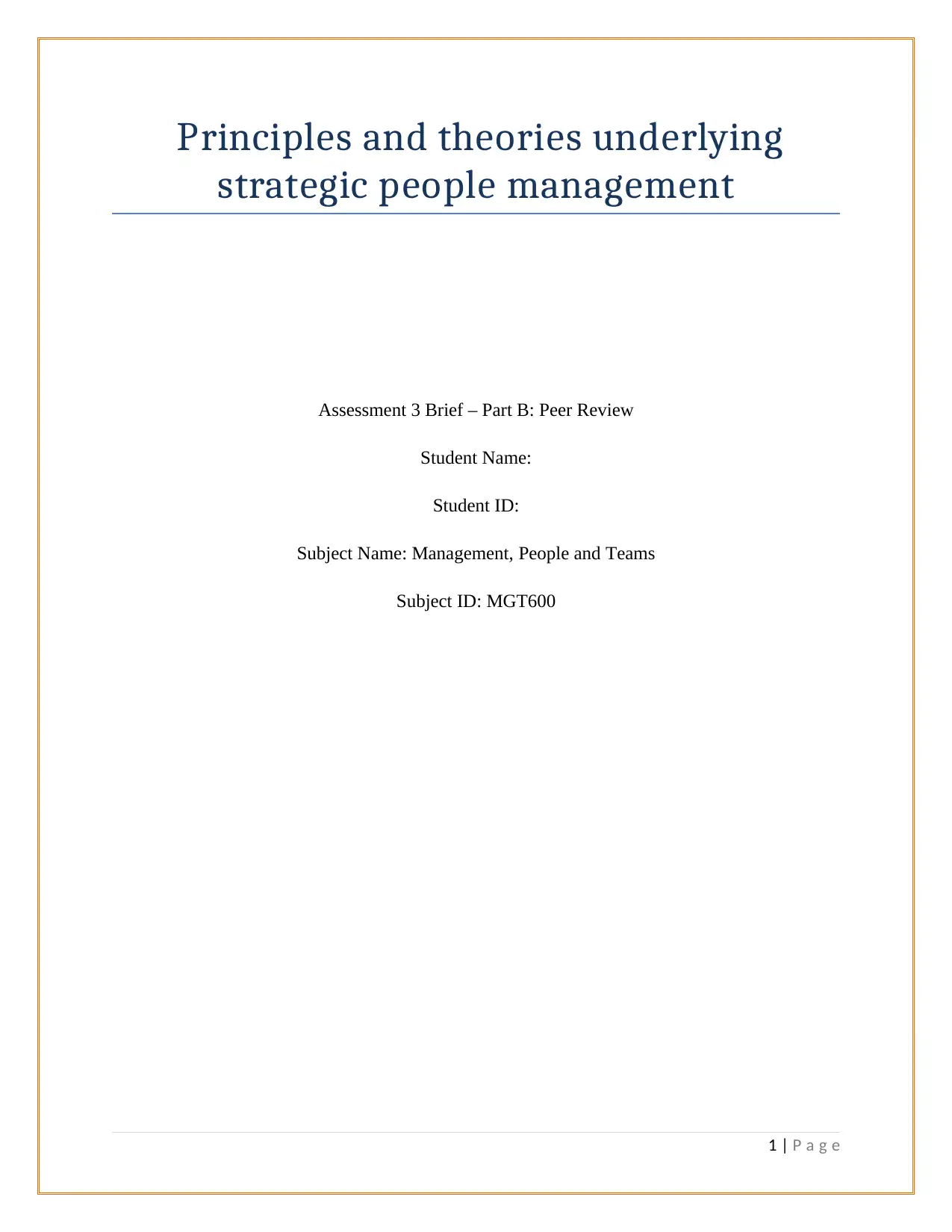
Principles and theories underlying
strategic people management
Assessment 3 Brief – Part B: Peer Review
Student Name:
Student ID:
Subject Name: Management, People and Teams
Subject ID: MGT600
1 | P a g e
strategic people management
Assessment 3 Brief – Part B: Peer Review
Student Name:
Student ID:
Subject Name: Management, People and Teams
Subject ID: MGT600
1 | P a g e
Paraphrase This Document
Need a fresh take? Get an instant paraphrase of this document with our AI Paraphraser
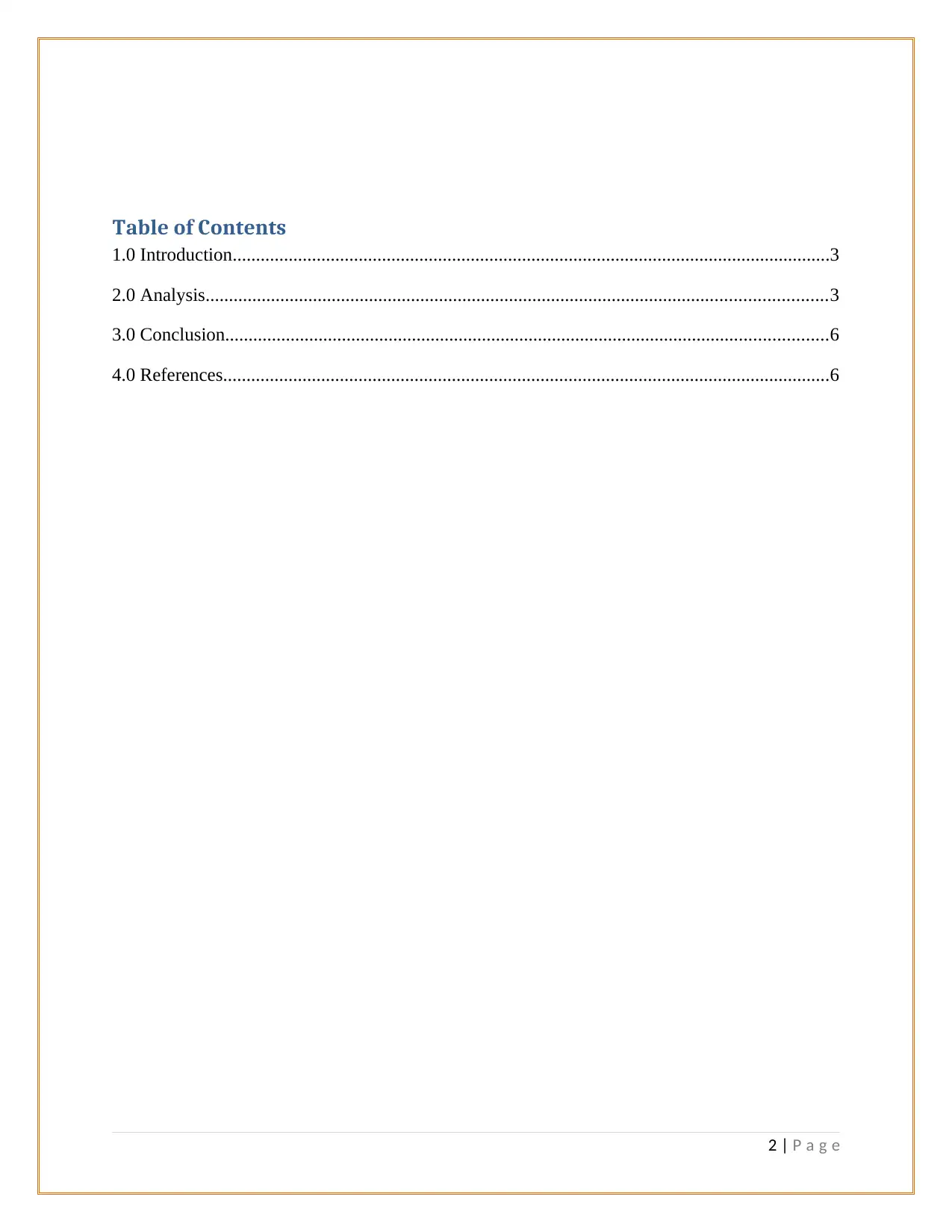
Table of Contents
1.0 Introduction................................................................................................................................3
2.0 Analysis.....................................................................................................................................3
3.0 Conclusion.................................................................................................................................6
4.0 References..................................................................................................................................6
2 | P a g e
1.0 Introduction................................................................................................................................3
2.0 Analysis.....................................................................................................................................3
3.0 Conclusion.................................................................................................................................6
4.0 References..................................................................................................................................6
2 | P a g e
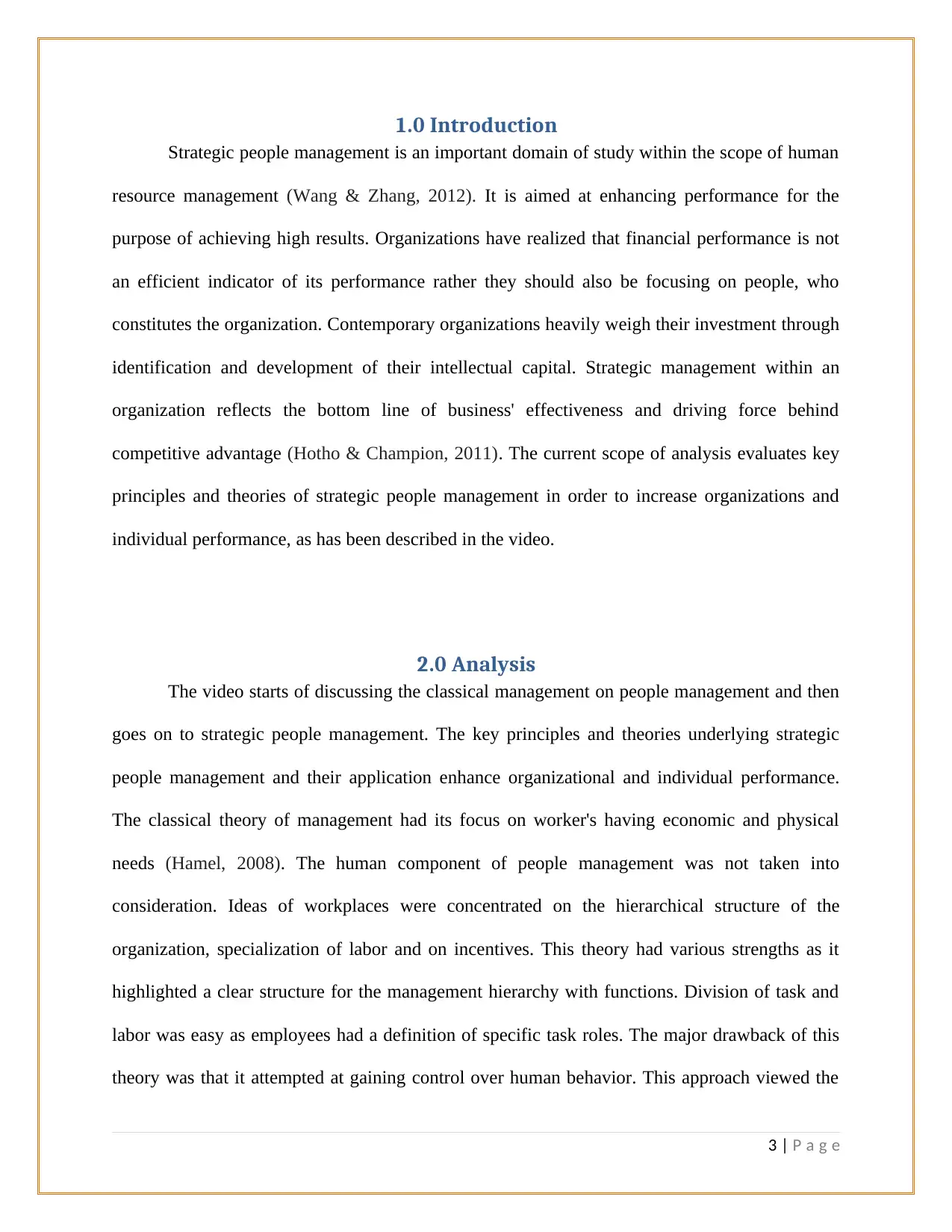
1.0 Introduction
Strategic people management is an important domain of study within the scope of human
resource management (Wang & Zhang, 2012). It is aimed at enhancing performance for the
purpose of achieving high results. Organizations have realized that financial performance is not
an efficient indicator of its performance rather they should also be focusing on people, who
constitutes the organization. Contemporary organizations heavily weigh their investment through
identification and development of their intellectual capital. Strategic management within an
organization reflects the bottom line of business' effectiveness and driving force behind
competitive advantage (Hotho & Champion, 2011). The current scope of analysis evaluates key
principles and theories of strategic people management in order to increase organizations and
individual performance, as has been described in the video.
2.0 Analysis
The video starts of discussing the classical management on people management and then
goes on to strategic people management. The key principles and theories underlying strategic
people management and their application enhance organizational and individual performance.
The classical theory of management had its focus on worker's having economic and physical
needs (Hamel, 2008). The human component of people management was not taken into
consideration. Ideas of workplaces were concentrated on the hierarchical structure of the
organization, specialization of labor and on incentives. This theory had various strengths as it
highlighted a clear structure for the management hierarchy with functions. Division of task and
labor was easy as employees had a definition of specific task roles. The major drawback of this
theory was that it attempted at gaining control over human behavior. This approach viewed the
3 | P a g e
Strategic people management is an important domain of study within the scope of human
resource management (Wang & Zhang, 2012). It is aimed at enhancing performance for the
purpose of achieving high results. Organizations have realized that financial performance is not
an efficient indicator of its performance rather they should also be focusing on people, who
constitutes the organization. Contemporary organizations heavily weigh their investment through
identification and development of their intellectual capital. Strategic management within an
organization reflects the bottom line of business' effectiveness and driving force behind
competitive advantage (Hotho & Champion, 2011). The current scope of analysis evaluates key
principles and theories of strategic people management in order to increase organizations and
individual performance, as has been described in the video.
2.0 Analysis
The video starts of discussing the classical management on people management and then
goes on to strategic people management. The key principles and theories underlying strategic
people management and their application enhance organizational and individual performance.
The classical theory of management had its focus on worker's having economic and physical
needs (Hamel, 2008). The human component of people management was not taken into
consideration. Ideas of workplaces were concentrated on the hierarchical structure of the
organization, specialization of labor and on incentives. This theory had various strengths as it
highlighted a clear structure for the management hierarchy with functions. Division of task and
labor was easy as employees had a definition of specific task roles. The major drawback of this
theory was that it attempted at gaining control over human behavior. This approach viewed the
3 | P a g e
⊘ This is a preview!⊘
Do you want full access?
Subscribe today to unlock all pages.

Trusted by 1+ million students worldwide
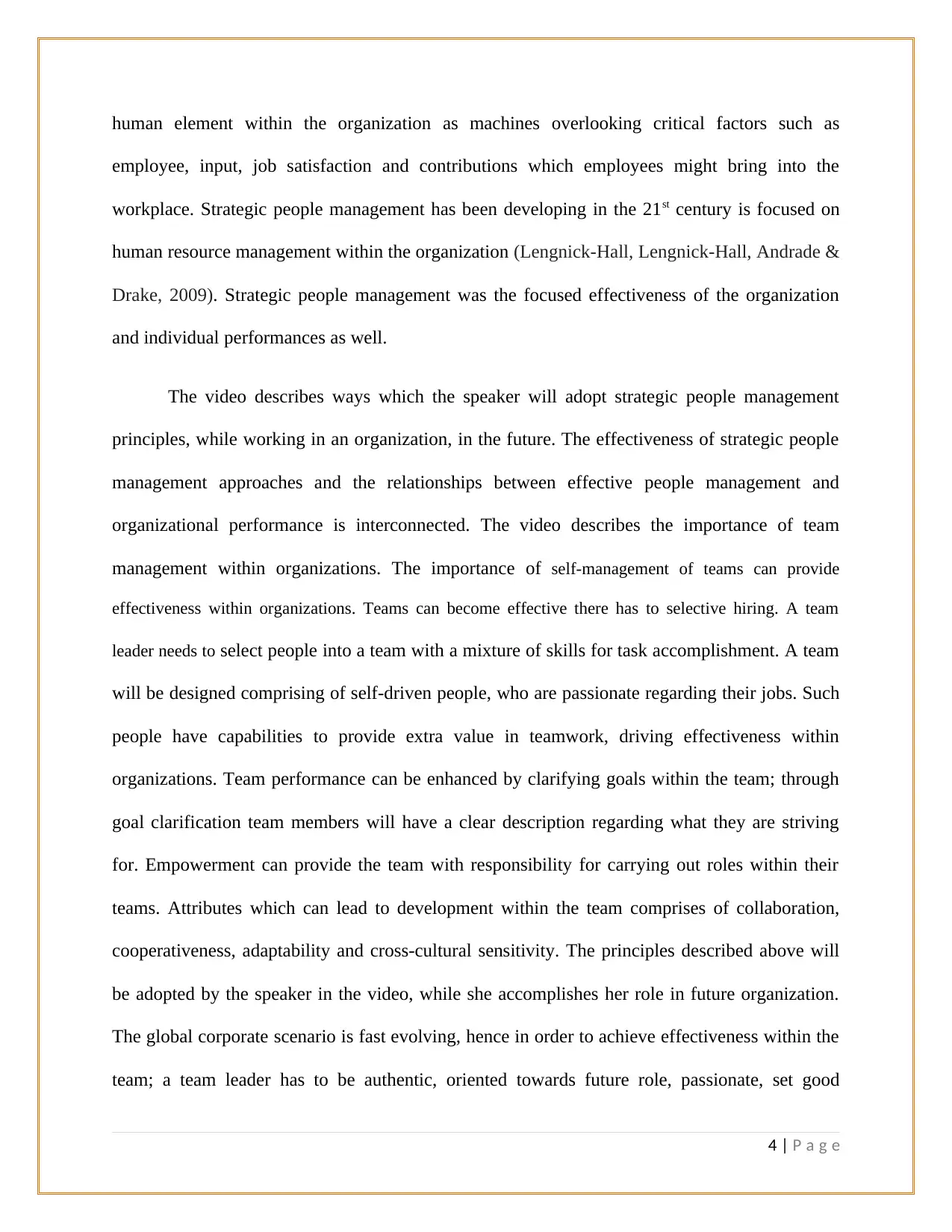
human element within the organization as machines overlooking critical factors such as
employee, input, job satisfaction and contributions which employees might bring into the
workplace. Strategic people management has been developing in the 21st century is focused on
human resource management within the organization (Lengnick-Hall, Lengnick-Hall, Andrade &
Drake, 2009). Strategic people management was the focused effectiveness of the organization
and individual performances as well.
The video describes ways which the speaker will adopt strategic people management
principles, while working in an organization, in the future. The effectiveness of strategic people
management approaches and the relationships between effective people management and
organizational performance is interconnected. The video describes the importance of team
management within organizations. The importance of self-management of teams can provide
effectiveness within organizations. Teams can become effective there has to selective hiring. A team
leader needs to select people into a team with a mixture of skills for task accomplishment. A team
will be designed comprising of self-driven people, who are passionate regarding their jobs. Such
people have capabilities to provide extra value in teamwork, driving effectiveness within
organizations. Team performance can be enhanced by clarifying goals within the team; through
goal clarification team members will have a clear description regarding what they are striving
for. Empowerment can provide the team with responsibility for carrying out roles within their
teams. Attributes which can lead to development within the team comprises of collaboration,
cooperativeness, adaptability and cross-cultural sensitivity. The principles described above will
be adopted by the speaker in the video, while she accomplishes her role in future organization.
The global corporate scenario is fast evolving, hence in order to achieve effectiveness within the
team; a team leader has to be authentic, oriented towards future role, passionate, set good
4 | P a g e
employee, input, job satisfaction and contributions which employees might bring into the
workplace. Strategic people management has been developing in the 21st century is focused on
human resource management within the organization (Lengnick-Hall, Lengnick-Hall, Andrade &
Drake, 2009). Strategic people management was the focused effectiveness of the organization
and individual performances as well.
The video describes ways which the speaker will adopt strategic people management
principles, while working in an organization, in the future. The effectiveness of strategic people
management approaches and the relationships between effective people management and
organizational performance is interconnected. The video describes the importance of team
management within organizations. The importance of self-management of teams can provide
effectiveness within organizations. Teams can become effective there has to selective hiring. A team
leader needs to select people into a team with a mixture of skills for task accomplishment. A team
will be designed comprising of self-driven people, who are passionate regarding their jobs. Such
people have capabilities to provide extra value in teamwork, driving effectiveness within
organizations. Team performance can be enhanced by clarifying goals within the team; through
goal clarification team members will have a clear description regarding what they are striving
for. Empowerment can provide the team with responsibility for carrying out roles within their
teams. Attributes which can lead to development within the team comprises of collaboration,
cooperativeness, adaptability and cross-cultural sensitivity. The principles described above will
be adopted by the speaker in the video, while she accomplishes her role in future organization.
The global corporate scenario is fast evolving, hence in order to achieve effectiveness within the
team; a team leader has to be authentic, oriented towards future role, passionate, set good
4 | P a g e
Paraphrase This Document
Need a fresh take? Get an instant paraphrase of this document with our AI Paraphraser
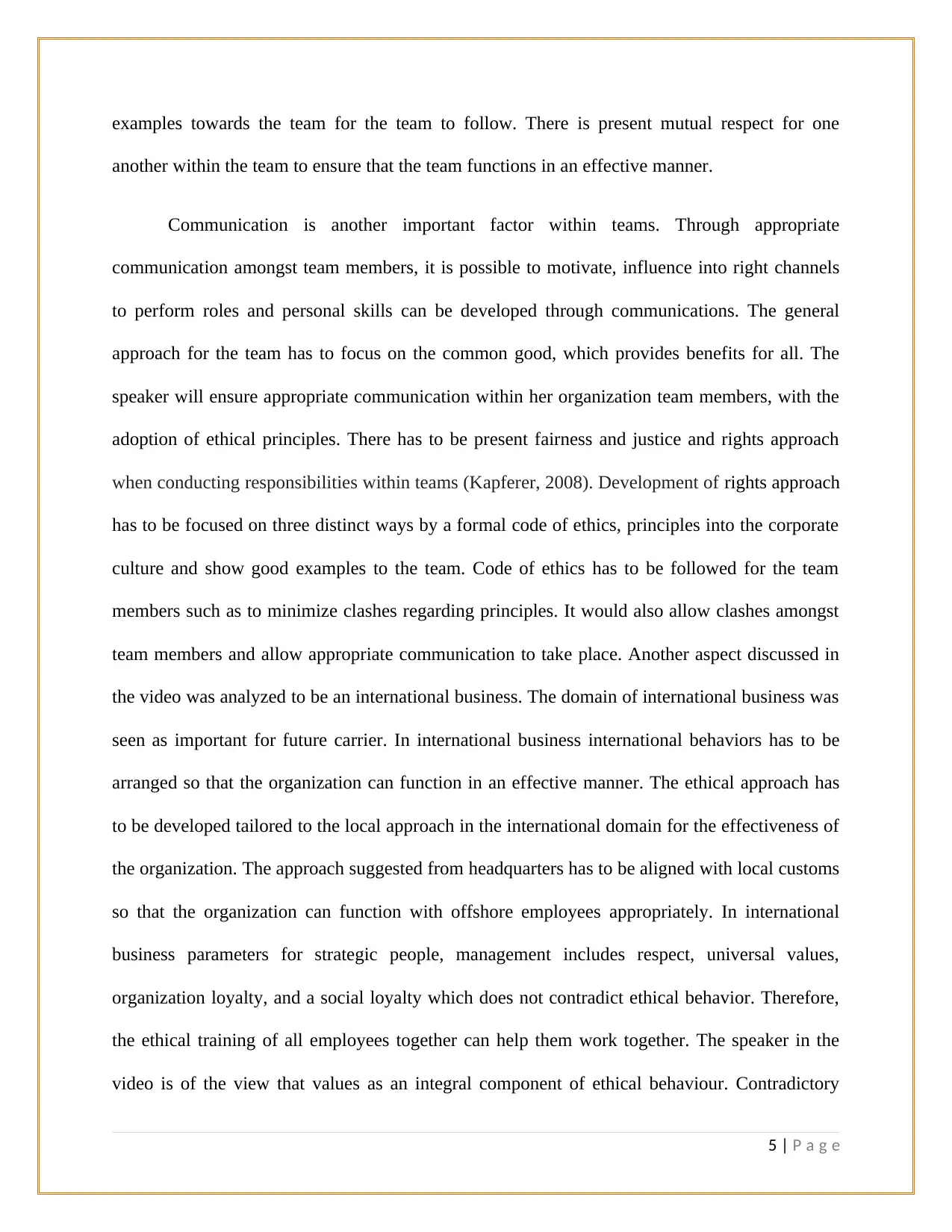
examples towards the team for the team to follow. There is present mutual respect for one
another within the team to ensure that the team functions in an effective manner.
Communication is another important factor within teams. Through appropriate
communication amongst team members, it is possible to motivate, influence into right channels
to perform roles and personal skills can be developed through communications. The general
approach for the team has to focus on the common good, which provides benefits for all. The
speaker will ensure appropriate communication within her organization team members, with the
adoption of ethical principles. There has to be present fairness and justice and rights approach
when conducting responsibilities within teams (Kapferer, 2008). Development of rights approach
has to be focused on three distinct ways by a formal code of ethics, principles into the corporate
culture and show good examples to the team. Code of ethics has to be followed for the team
members such as to minimize clashes regarding principles. It would also allow clashes amongst
team members and allow appropriate communication to take place. Another aspect discussed in
the video was analyzed to be an international business. The domain of international business was
seen as important for future carrier. In international business international behaviors has to be
arranged so that the organization can function in an effective manner. The ethical approach has
to be developed tailored to the local approach in the international domain for the effectiveness of
the organization. The approach suggested from headquarters has to be aligned with local customs
so that the organization can function with offshore employees appropriately. In international
business parameters for strategic people, management includes respect, universal values,
organization loyalty, and a social loyalty which does not contradict ethical behavior. Therefore,
the ethical training of all employees together can help them work together. The speaker in the
video is of the view that values as an integral component of ethical behaviour. Contradictory
5 | P a g e
another within the team to ensure that the team functions in an effective manner.
Communication is another important factor within teams. Through appropriate
communication amongst team members, it is possible to motivate, influence into right channels
to perform roles and personal skills can be developed through communications. The general
approach for the team has to focus on the common good, which provides benefits for all. The
speaker will ensure appropriate communication within her organization team members, with the
adoption of ethical principles. There has to be present fairness and justice and rights approach
when conducting responsibilities within teams (Kapferer, 2008). Development of rights approach
has to be focused on three distinct ways by a formal code of ethics, principles into the corporate
culture and show good examples to the team. Code of ethics has to be followed for the team
members such as to minimize clashes regarding principles. It would also allow clashes amongst
team members and allow appropriate communication to take place. Another aspect discussed in
the video was analyzed to be an international business. The domain of international business was
seen as important for future carrier. In international business international behaviors has to be
arranged so that the organization can function in an effective manner. The ethical approach has
to be developed tailored to the local approach in the international domain for the effectiveness of
the organization. The approach suggested from headquarters has to be aligned with local customs
so that the organization can function with offshore employees appropriately. In international
business parameters for strategic people, management includes respect, universal values,
organization loyalty, and a social loyalty which does not contradict ethical behavior. Therefore,
the ethical training of all employees together can help them work together. The speaker in the
video is of the view that values as an integral component of ethical behaviour. Contradictory
5 | P a g e
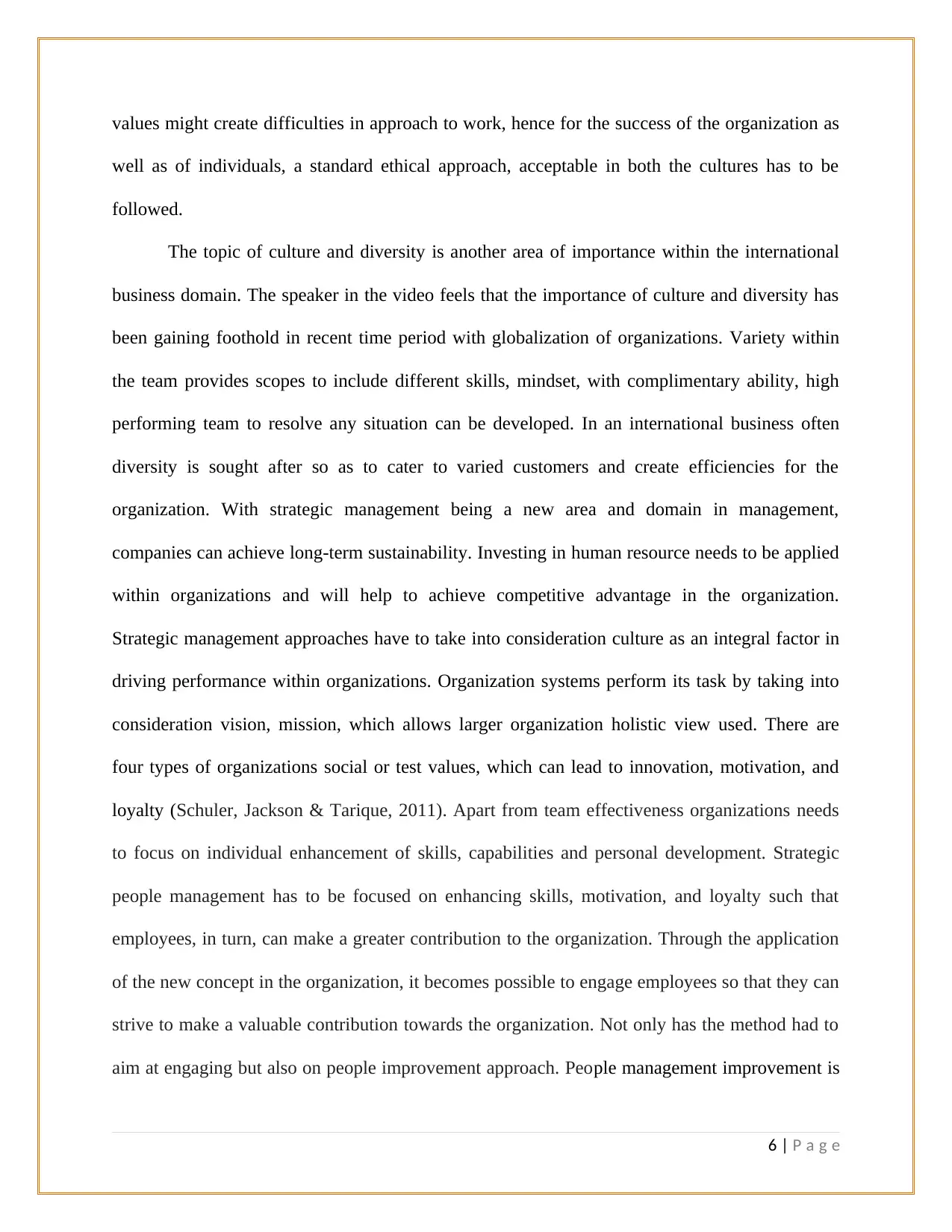
values might create difficulties in approach to work, hence for the success of the organization as
well as of individuals, a standard ethical approach, acceptable in both the cultures has to be
followed.
The topic of culture and diversity is another area of importance within the international
business domain. The speaker in the video feels that the importance of culture and diversity has
been gaining foothold in recent time period with globalization of organizations. Variety within
the team provides scopes to include different skills, mindset, with complimentary ability, high
performing team to resolve any situation can be developed. In an international business often
diversity is sought after so as to cater to varied customers and create efficiencies for the
organization. With strategic management being a new area and domain in management,
companies can achieve long-term sustainability. Investing in human resource needs to be applied
within organizations and will help to achieve competitive advantage in the organization.
Strategic management approaches have to take into consideration culture as an integral factor in
driving performance within organizations. Organization systems perform its task by taking into
consideration vision, mission, which allows larger organization holistic view used. There are
four types of organizations social or test values, which can lead to innovation, motivation, and
loyalty (Schuler, Jackson & Tarique, 2011). Apart from team effectiveness organizations needs
to focus on individual enhancement of skills, capabilities and personal development. Strategic
people management has to be focused on enhancing skills, motivation, and loyalty such that
employees, in turn, can make a greater contribution to the organization. Through the application
of the new concept in the organization, it becomes possible to engage employees so that they can
strive to make a valuable contribution towards the organization. Not only has the method had to
aim at engaging but also on people improvement approach. People management improvement is
6 | P a g e
well as of individuals, a standard ethical approach, acceptable in both the cultures has to be
followed.
The topic of culture and diversity is another area of importance within the international
business domain. The speaker in the video feels that the importance of culture and diversity has
been gaining foothold in recent time period with globalization of organizations. Variety within
the team provides scopes to include different skills, mindset, with complimentary ability, high
performing team to resolve any situation can be developed. In an international business often
diversity is sought after so as to cater to varied customers and create efficiencies for the
organization. With strategic management being a new area and domain in management,
companies can achieve long-term sustainability. Investing in human resource needs to be applied
within organizations and will help to achieve competitive advantage in the organization.
Strategic management approaches have to take into consideration culture as an integral factor in
driving performance within organizations. Organization systems perform its task by taking into
consideration vision, mission, which allows larger organization holistic view used. There are
four types of organizations social or test values, which can lead to innovation, motivation, and
loyalty (Schuler, Jackson & Tarique, 2011). Apart from team effectiveness organizations needs
to focus on individual enhancement of skills, capabilities and personal development. Strategic
people management has to be focused on enhancing skills, motivation, and loyalty such that
employees, in turn, can make a greater contribution to the organization. Through the application
of the new concept in the organization, it becomes possible to engage employees so that they can
strive to make a valuable contribution towards the organization. Not only has the method had to
aim at engaging but also on people improvement approach. People management improvement is
6 | P a g e
⊘ This is a preview!⊘
Do you want full access?
Subscribe today to unlock all pages.

Trusted by 1+ million students worldwide
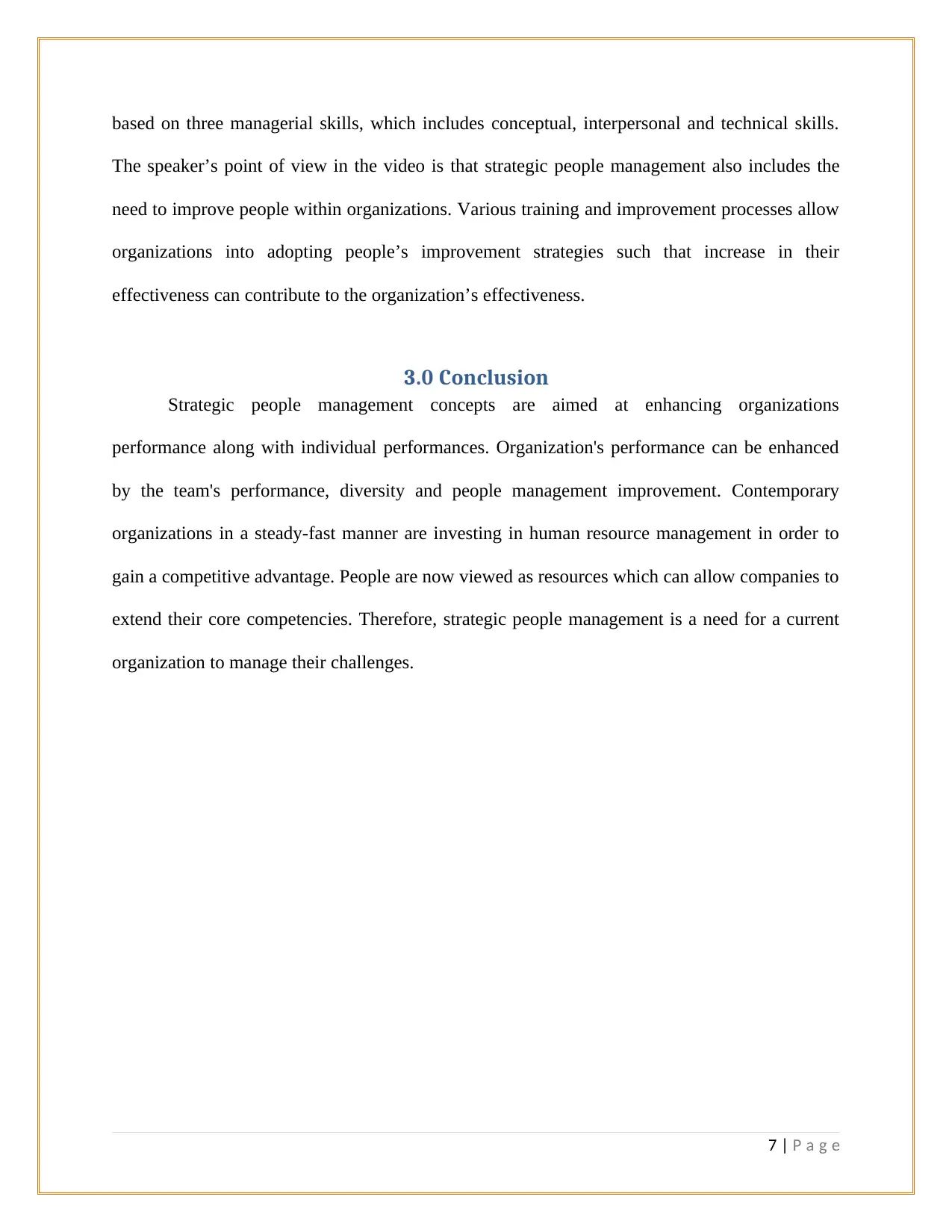
based on three managerial skills, which includes conceptual, interpersonal and technical skills.
The speaker’s point of view in the video is that strategic people management also includes the
need to improve people within organizations. Various training and improvement processes allow
organizations into adopting people’s improvement strategies such that increase in their
effectiveness can contribute to the organization’s effectiveness.
3.0 Conclusion
Strategic people management concepts are aimed at enhancing organizations
performance along with individual performances. Organization's performance can be enhanced
by the team's performance, diversity and people management improvement. Contemporary
organizations in a steady-fast manner are investing in human resource management in order to
gain a competitive advantage. People are now viewed as resources which can allow companies to
extend their core competencies. Therefore, strategic people management is a need for a current
organization to manage their challenges.
7 | P a g e
The speaker’s point of view in the video is that strategic people management also includes the
need to improve people within organizations. Various training and improvement processes allow
organizations into adopting people’s improvement strategies such that increase in their
effectiveness can contribute to the organization’s effectiveness.
3.0 Conclusion
Strategic people management concepts are aimed at enhancing organizations
performance along with individual performances. Organization's performance can be enhanced
by the team's performance, diversity and people management improvement. Contemporary
organizations in a steady-fast manner are investing in human resource management in order to
gain a competitive advantage. People are now viewed as resources which can allow companies to
extend their core competencies. Therefore, strategic people management is a need for a current
organization to manage their challenges.
7 | P a g e
Paraphrase This Document
Need a fresh take? Get an instant paraphrase of this document with our AI Paraphraser
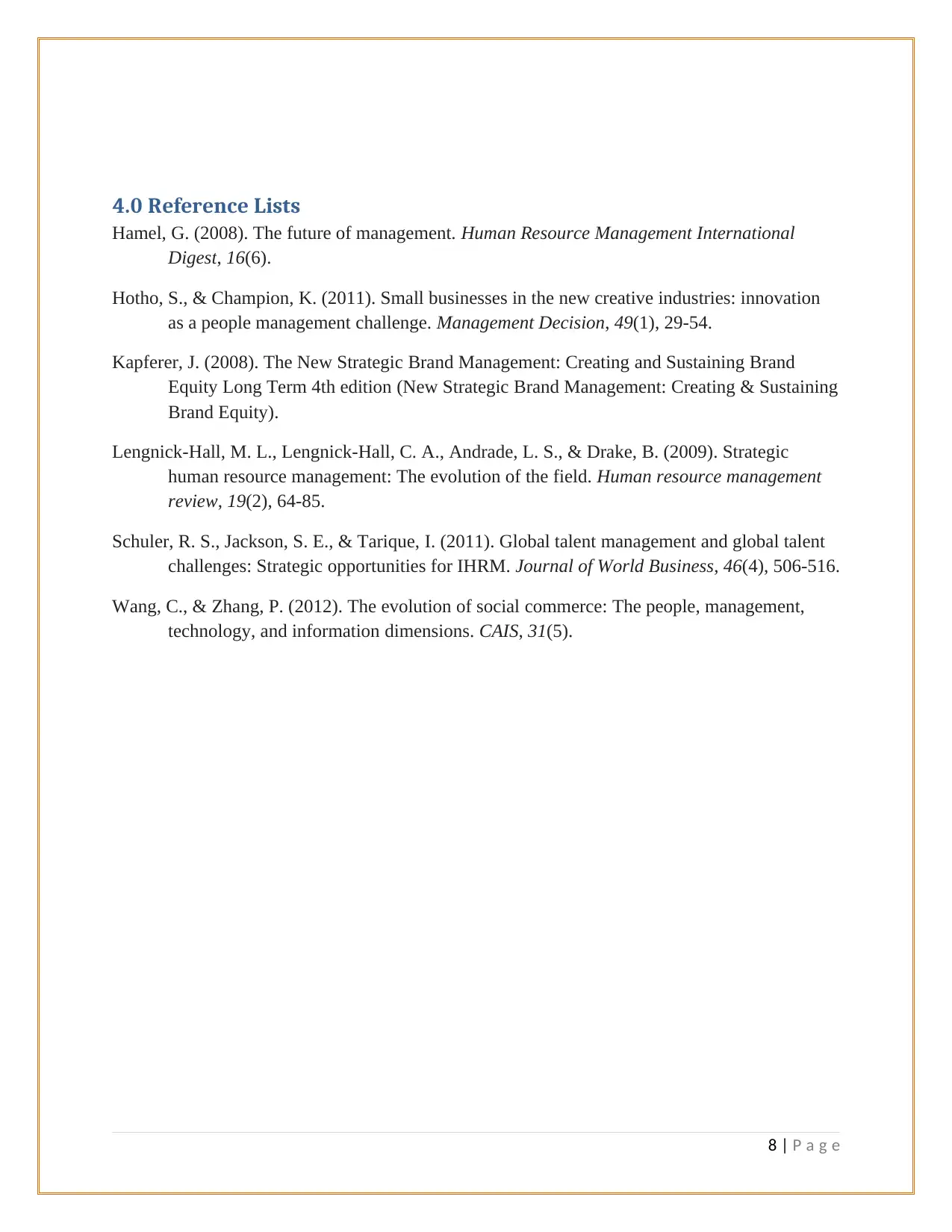
4.0 Reference Lists
Hamel, G. (2008). The future of management. Human Resource Management International
Digest, 16(6).
Hotho, S., & Champion, K. (2011). Small businesses in the new creative industries: innovation
as a people management challenge. Management Decision, 49(1), 29-54.
Kapferer, J. (2008). The New Strategic Brand Management: Creating and Sustaining Brand
Equity Long Term 4th edition (New Strategic Brand Management: Creating & Sustaining
Brand Equity).
Lengnick-Hall, M. L., Lengnick-Hall, C. A., Andrade, L. S., & Drake, B. (2009). Strategic
human resource management: The evolution of the field. Human resource management
review, 19(2), 64-85.
Schuler, R. S., Jackson, S. E., & Tarique, I. (2011). Global talent management and global talent
challenges: Strategic opportunities for IHRM. Journal of World Business, 46(4), 506-516.
Wang, C., & Zhang, P. (2012). The evolution of social commerce: The people, management,
technology, and information dimensions. CAIS, 31(5).
8 | P a g e
Hamel, G. (2008). The future of management. Human Resource Management International
Digest, 16(6).
Hotho, S., & Champion, K. (2011). Small businesses in the new creative industries: innovation
as a people management challenge. Management Decision, 49(1), 29-54.
Kapferer, J. (2008). The New Strategic Brand Management: Creating and Sustaining Brand
Equity Long Term 4th edition (New Strategic Brand Management: Creating & Sustaining
Brand Equity).
Lengnick-Hall, M. L., Lengnick-Hall, C. A., Andrade, L. S., & Drake, B. (2009). Strategic
human resource management: The evolution of the field. Human resource management
review, 19(2), 64-85.
Schuler, R. S., Jackson, S. E., & Tarique, I. (2011). Global talent management and global talent
challenges: Strategic opportunities for IHRM. Journal of World Business, 46(4), 506-516.
Wang, C., & Zhang, P. (2012). The evolution of social commerce: The people, management,
technology, and information dimensions. CAIS, 31(5).
8 | P a g e
1 out of 8
Related Documents
Your All-in-One AI-Powered Toolkit for Academic Success.
+13062052269
info@desklib.com
Available 24*7 on WhatsApp / Email
![[object Object]](/_next/static/media/star-bottom.7253800d.svg)
Unlock your academic potential
Copyright © 2020–2025 A2Z Services. All Rights Reserved. Developed and managed by ZUCOL.




